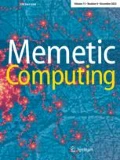Abstract
Malignant melanoma is the deadliest form of skin cancer, and has, among cancer types, one of the most rapidly increasing incidence rates in the world. Early diagnosis is crucial, since if detected early, its cure is simple. In this paper, we present an effective approach to melanoma identification from dermoscopic images of skin lesions based on ensemble classification. First, we perform automatic border detection to segment the lesion from the background skin. Based on the extracted border, we extract a series of colour, texture and shape features. The derived features are then employed in a pattern classification stage for which we employ a novel, dedicated ensemble learning approach to address the class imbalance in the training data and to yield improved classification performance. Our classifier committee trains individual classifiers on balanced subspaces, removes redundant predictors based on a diversity measure and combines the remaining classifiers using a neural network fuser. Experimental results on a large dataset of dermoscopic skin lesion images show our approach to work well, to provide both high sensitivity and specificity, and our presented classifier ensemble to lead to statistically better recognition performance compared to other dedicated classification algorithms.




Similar content being viewed by others
References
Alpaydin E (1999) Combined \(5 \times 2\) CV F test for comparing supervised classification learning algorithms. Neural Comput 11(8):1885–1892
Argenziano G, Soyer HP, De Giorgi V (2002) Dermoscopy: a tutorial. EDRA Medical Publishing & New Media, Milan
Binder M, Schwarz M, Winkler A, Steiner A, Kaider A, Wolff K, Pehamberger H (1995) Epiluminescence microscopy. A useful tool for the diagnosis of pigmented skin lesions for formally trained dermatologists. Arch Dermatol 131(3):286–291
Blaszczynski J, Deckert M, Stefanowski J, Wilk S (2010) Integrating selective pre-processing of imbalanced data with Ivotes ensemble. In: 7th International conference rough sets and current trends in computing, pp 148–157
Celebi ME, Aslandogan YA, Stoecker WV, Iyatomi H, Oka H, Chen X (2007) Unsupervised border detection in dermoscopy images. Skin Res Technol 13(4):454–462
Celebi ME, Kingravi H, Uddin B, Iyatomi H, Aslandogan A, Stoecker WV, Moss RH (2007) A methodological approach to the classification of dermoscopy images. Comput Med Imaging Graph 31(6):362–373
Celebi ME, Iyatomi H, Schaefer G, Stoecker WV (2009) Lesion border detection in dermoscopy images. Comput Med Imaging Graph 33(2):148–153
Chawla NV, Bowyer KW, Hall LO, Kegelmeyer WP (2002) SMOTE: synthetic minority over-sampling technique. J Artif Intell Res 16:321–357
Chawla NV, Lazarevic A, Hall LO, Bowyer KW (2003) SMOTEBoost: improving prediction of the minority class in boosting. In: 7th European conference on principles and practice of knowledge discovery in database, pp 107–119
Deng Y, Manjunath BS (2001) Unsupervised segmentation of color-texture regions in images and video. IEEE Trans Pattern Anal Mach Intell 23(8):800–810
Fleming MG, Steger C, Zhang J, Gao J, Cognetta AB, Pollak I, Dyer CR (1998) Techniques for a structural analysis of dermatoscopic imagery. Comput Med Imaging Graph 22(5):375–389
Golestani A, Azimi J, Analoui M, Kangavari M (2007) A new efficient fuzzy diversity measure in classifier fusion. In: IADIS international conference of applied computing, pp 722–726
Haralick RM (1979) Statistical and structural approaches to texture. Proc IEEE 67(5):786–804
Karatzoglou A, Smola A, Hornik K, Zeileis A (2004) Kernlab, an S4 package for kernel methods. R J Stat Softw 11(9):1–20
Koch MW, Moya MM, Hostetler LD, Fogler RJ (1995) Cueing, feature discovery, and one-class learning for synthetic aperture radar automatic target recognition. Neural Netw 8(7–8):1081–1102
Krawczyk B, Schaefer G (2012) Effective multiple classier systems for breast thermogram analysis. In: 21st International conference on pattern recognition, pp 3345–3348
Krawczyk B, Schaefer G, Wozniak M (2013) Combining one-class classifiers for imbalanced classification of breast thermogram features. In: 4th International workshop on computational intelligence in medical imaging, 2013. Held as part of IEEE symposium series on computational intelligence
Krawczyk B, Schaefer G, Wozniak M (2013) A cost-sensitive ensemble classifier for breast cancer classification. In: IEEE 8th international symposium on applied computational intelligence and informatics, pp 427–430
Kuncheva LI (2004) Combining pattern classifiers: methods and algorithms. Wiley-Interscience, New Jersey
Liu X, Wu J, Zhou Z (2009) Exploratory undersampling for class-imbalance learning. IEEE Trans Syst Man Cybern Part B Cybern 39(2):539–550
Liu Y, Chawla NV, Harper MP, Shriberg E, Stolcke A (2006) A study in machine learning from imbalanced data for sentence boundary detection in speech. Comput Speech Lang 20:468–494
Menzies SW, Crotty KA, Ingwar C, McCarth WH (2003) An atlas of surface microscopy of pigmented skin lesions: dermoscopy, 2nd edn. McGraw-Hill, Sydney
Nakashima T, Yokota Y, Ishibuchi H, Schaefer G, Drastich A, Zavisek M (2007) Constructing cost-sensitive fuzzy rule-based classification systems for pattern classification problems. J Adv Comput Intell Intell Inf 11(6):546–553
Siegel R, Naishadham D, Jemal A (2013) Cancer statistics, 2013. CA: Cancer J Clin 63(1):11–30
Steiner K, Binder M, Schemper M, Wolff K, Pehamberger H (1993) Statistical evaluation of epiluminescence dermoscopy criteria for melanocytic pigmented lesions. J Am Acad Dermatol 29(4):581–588
Sun Y, Kamel MS, Wong AKC, Wang Y (2007) Cost-sensitive boosting for classification of imbalanced data. Pattern Recognit 40(12):3358–3378
Vapnik VN (1998) Statistical learning theory. Wiley, New York
Wang S, Yao X (2009) Diversity analysis on imbalanced data sets by using ensemble models. In: IEEE symposium on computational intelligence and data mining, pp 324–331
Wozniak M, Zmyslony M (2010) Designing combining classifier with trained fuser—analytical and experimental evaluation. Neural Netw World 20(7):925–934
Yu L, Liu H (2004) Efficient feature selection via analysis of relevance and redundancy. J Mach Learn Res 5:1205–1224
Author information
Authors and Affiliations
Corresponding author
Rights and permissions
About this article
Cite this article
Schaefer, G., Krawczyk, B., Celebi, M.E. et al. An ensemble classification approach for melanoma diagnosis. Memetic Comp. 6, 233–240 (2014). https://doi.org/10.1007/s12293-014-0144-8
Received:
Accepted:
Published:
Issue Date:
DOI: https://doi.org/10.1007/s12293-014-0144-8




